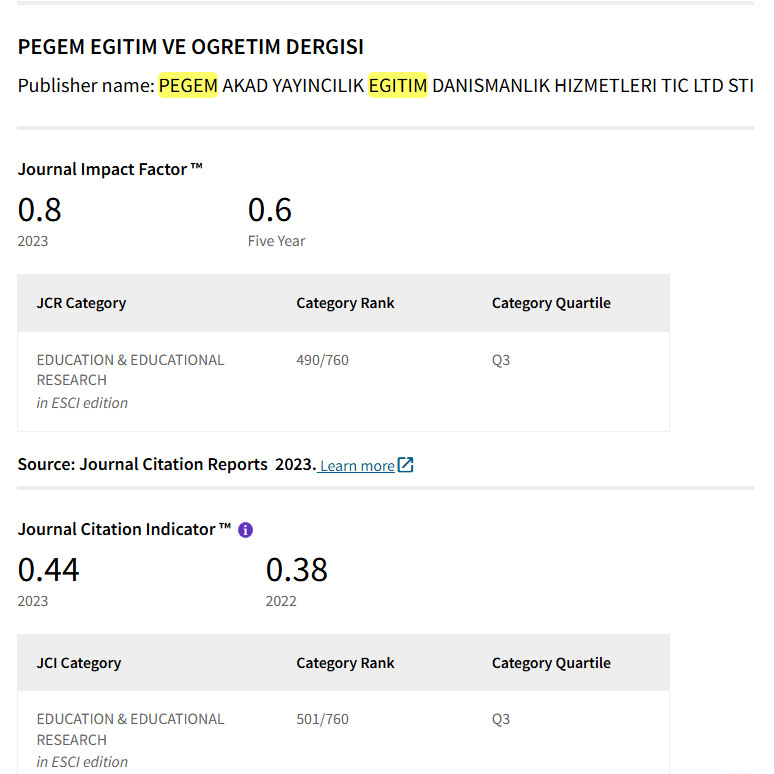Development of Learning Application for College Students with Special Needs using Universal Design for Learning
DOI:
https://doi.org/10.47750/pegegog.13.03.32Keywords:
learning application, college students with special needs, universal design for learningAbstract
This study aims to (1) analyze the learning needs of college students with special needs, (2) develop a Universal Design for Learning based learning application named AJAR MBK, and 3) assess the efficiency of the AJAR MBK application. It used a research and development model adapted from the ADDIE (analysis, design, development, implementation, and evaluation) development model. Our analysis results showed the learning needs of college students with special needs, which were used in the AJAR MBK learning application development. Further, the AJAR MBK’s feasibility test results showed 4.56 and 4.67 scores from the experts in learning materials and media, respectively. Both feasibility scores were classified as very feasible. Meanwhile, the average feasibility score from the students with special needs was 4.6, categorized as very feasible. Our last analysis results showed that the developed learning media was effective to be used as presented by students’ average final score in the education for children with spectrum autism course that increased by 15.4% from their pretest score. The higher posttest score than the pretest score confirmed that the AJAR MBK is effective to be used by students with special needs in the education for children with spectrum autism course.
Downloads
References
Almumen, H. A. (2020). Universal Design for Learning (UDL) Across Cultures: The Application of UDL in Kuwaiti Inclusive Classrooms. SAGE Open, 10(4). https://doi.org/10.1177/2158244020969674.
Azimi, M., Rachman. A, dan Mirnawati. (2020). Problematik Pembelajaran Mahasiswa Berkebutuhan Khusus pada Perguruan Tinggi Inklusif. Vidya Karya, 35 (2), 55-62. Diakses dari https://ppjp.ulm.ac.id/journal/index-.php/JVK/index.
Black, R. D., Weinberg, L. A., & Brodwin, M. G. (2014). Universal design for instruction and learning: A pilot study of faculty instructional methods and attitudes related to students with disabilities in higher education. Exceptionality Education International, 24(1), 48–64. https://doi.org/10.5206/eei.v24i1.7710.
Davies, P. L., Schelly, C. L., & Spooner, C. L. (2013). Measuring the Effectiveness of Universal Design for Learning Intervention in Postsecondary Education. Journal of Postsecondary Education and Disability, 26(3), 195–220.
Evmenova, A. (2018). Preparing Teachers to Use Universal Design for Learning to Support Diverse Learners. Journal of Online Learning Research, 4(2), 147-171.
Fenrich, P., Carson, T., & Overgaard, M. (2018). Higher Education, Lifelong Learning & Social Inclusion: Comparing Traditional Learning Materials with Those Created with Instructional Design and Universal Design for Learning Attributes: The Students’ Perspective. Education in Modern Society, 16, 143–149. Retrieved from https://files.eric.ed.gov/fulltext/ED586138.pdf.
Flagg-Williams, J., & Bokhorst-Heng, W. (2016). Classroom audio distribution in the postsecondary setting: A story of universal design for learning. Journal of Postsecondary Education and Disability, 29(2), 165–177.
Junaidi, Aris (2020). Panduan Bantuan Dana Inovasi Pembelajaran dan Teknologi Bantu (Teknologi Asistif) untuk Mahasiswa Berkebutuhan Khusus di Perguruan Tinggi Tahun 2020. Jakarta: Direktorat Pembelajaran dan Kemahasiswaan Direktorat Jenderal Pendidikan Tinggi Kementerian Pendidikan dan Kebudayaan.
Kilpatrick, J. (2021). Learning from COVID-19: Universal Design for Learning Implementation Prior to and During a Pandemic. Journal of Applied Instructional Design, 10(1), 1–17. https://doi.org/10.51869/101jkmbse.
Lowrey, K. A., Hollingshead, A., Howery, K., & Bishop, J. B. (2017). More Than One Way: Stories of UDL and Inclusive Classrooms. Research and Practice for Persons with Severe Disabilities, 42(4), 225–242. https://doi.org/10.1177/1540796917711668
Parker, Holly Buckland. 2012. Learning Starts with Design: Using Universal Design for Learning (UDL) in Higher Education Course Redesign. Vol. 16. Emerald Group Publishing Ltd.
Pemerintahan Indonesia. (2016). Undang-Undang Nomor 8 Tahun 2016 Tentang Penyandang Disabilitas.
Peraturan Menteri Riset. (2017).Teknologi, dan Pendidikan Tinggi Nomor 46 Tahun 2017 tentang Pendidikan Khusus dan Pendidikan Layanan.
Robinson, D. E., & Wizer, D. R. (2016). Universal Design for Learning and the Quality Matters Guidelines for the design and implementation of online learning events. International Journal of Technology in Teaching & Learning, 12,17-32.
Setiadi, Yuliatmojo, dan Nurhidayat. (2018). Pengembangan Aplikasi Android untuk Pembelajaran Pneumatik. Jurnal Pendidikan Vokasional Teknik Elektronika, 1 (1), 1-5.
Shin, M., Kang, E., & Lee, O. (2021). High School Students ’ Perceptions of Mathematics Teachers ’ Implementation of UDL-Based Practices and Technology in Mathematics Classes. 17(2).
Siu, K. W. M., & Lam, M. S. (2012). Public Computer Assisted Learning Facilities for Children with Visual Impairment: Universal Design for Inclusive Learning. Early Childhood Education Journal, 40(5), 295–303. https://doi.org/10.1007/s10643-011-0502-9
Sugiyono. (2016). Metode Penelitian. Bandung: Alfabeta.
Utomo, J. T. (2015). Universal Design for Learning : Pengertian, Prinsip, dan Penerapan. Seminar Nasional Teknologi Pendidikan, Malang: 14 November 2015. Hal.703-711.
Windy, Y. D., Ningtyas, K., Amilia, F., & Kamilah, N. (2020). Inovasi Model Desain Universal untuk Pembelajaran Kebutuhan Khusus di Perguruan Tinggi. Pendidikan, 5(20), 24–29.
Downloads
Published
How to Cite
Issue
Section
License
Copyright (c) 2023 Pegem Journal of Education and Instruction

This work is licensed under a Creative Commons Attribution-NonCommercial 4.0 International License.
Attribution — You must give appropriate credit, provide a link to the license, and indicate if changes were made. You may do so in any reasonable manner, but not in any way that suggests the licensor endorses you or your use.
NonCommercial — You may not use the material for commercial purposes.
No additional restrictions — You may not apply legal terms or technological measures that legally restrict others from doing anything the license permits.



